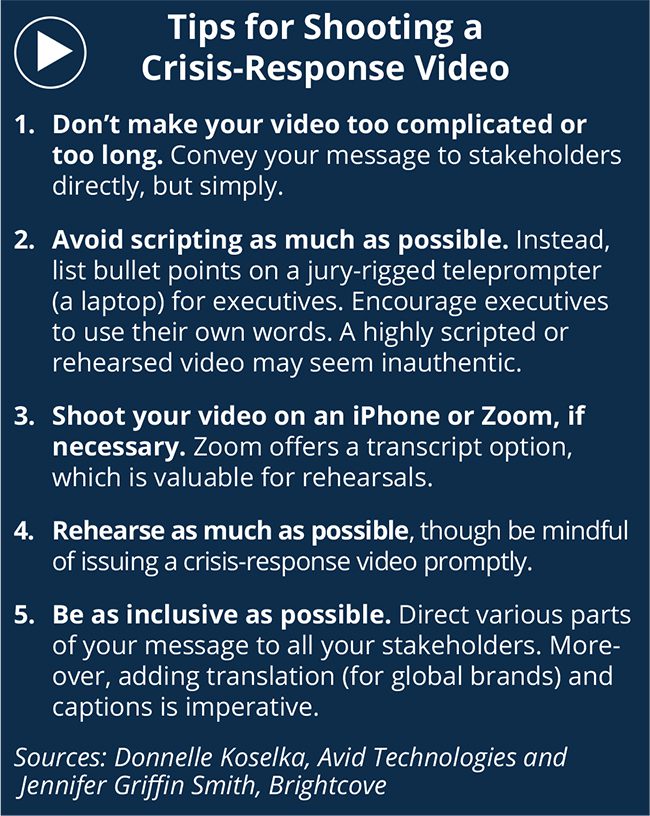
PR pros worry about social media attacks billowing into a PR crisis. Sometimes, though, an innocent conversation on social can spur a crisis. That was the case with Avid Technologies. How Avid handled its crisis–promptly, simply, inclusively and authentically–is the story. It’s also a story about how a high-tech company went low-tech in a PR crisis.
A Massachusetts-based media-entertainment technology company of 1,500 employees, including five communicators, Avid designs film- and video-editing software, as well as concert hall sound boards, among other products. If you saw any of the 2022 Best Picture-nominated films, watch TV or attend concerts, you’ve likely experienced Avid technology.
Rebooting Ad Infinitum
In late-September 2019, editors using Avid’s Media Composer, on Mac computers, were unable to get it to reboot.
Avid enjoys an enviable leadership position, especially with professional film and TV editors. Unfortunately, when problems arise with a leader, news can spread fast. Indeed, film editors, a tight-knit community, immediately chatted on social about Media Composer’s problems during the evening of Sept. 23, 2019.
For example, editors at “Modern Family,” the hit TV series, were on deadline, tweaking a season finale. They took to Twitter, wondering if anyone else was experiencing Composer problems.
In a recent interview, Avid director of corporate communication Donnelle Koselka recalls alarm bells going off when she saw those Twitter chats.
Media Coverage
Indeed, the situation included several elements of a prototypical PR crisis, such as media coverage. “Variety,” the 116-year-old Hollywood trade, posted a story Sept. 23, at 10:58 pm PT.
Variety’s senior Silicon Valley reporter Janko Roettgers led his story this way: “Film and TV editors across Los Angeles were sweating Monday evening as their workstations were refusing to reboot, resulting in speculations about a possible computer virus attack. Social media reports suggested that the issue was widespread among users of Mac Pro computers running older versions of Apple’s operating system as well as Avid’s Media Composer software.”
Prompt Response
The next morning, Avid teams visited customer sites so they could assess the situation, Koselka says.
Simultaneously, Koselka’s team went into crisis communication mode. It posted a statement alerting customers that it was aware of the situation.
Later in the day, Avid learned how some customers worked around the problem. In part, that’s why it decided a video was “the best way to respond,” Koselka says.
Video could allow Avid executives to project composure and discuss temporary workarounds. In addition, the team believed video was the best method to explain the workarounds.
Jennifer Griffin Smith, CMO at Brightcove, whose products help businesses store, deploy and gather data about video, says Avid’s thinking about video’s advantages for crisis response was proven during the pandemic.
“We know now people trust executives more when they can see them [on video],” she says. In addition, “no matter where you were in the world, you could see” Avid’s CEO on the video, she says.
She also applauds Avid’s use of video to explain workarounds. “It would have taken several written pages to explain” the temporary fixes. Avid did it in a short video.
Three-Minute Video
Issued that day, the three-minute video featured CEO Jeff Rosica, appearing calm in a casual sport shirt, seated next to a desk, not behind it. The background behind him was uncomplicated.
Avid is “looking at every possibility with our engineering team, as well as with Apple and other third-party vendors” to find and “rectify” the issue, Rosica said. “We’re taking this issue very seriously…[and] working around the clock…[and] diligently, quickly to find the issue and get a resolution into the field as fast as we can.”
At 54 seconds in, he gave way to Dan Ruzicka, Avid’s chief product officer. Also dressed casually and seated in a nondescript cube, Ruzicka offered steps users could take to temporarily fix the reboot problem. Importantly, as he spoke, the fixes and instructions were repeated in a text box, on screen to the left.
Using simple language, he noted the problem presents as a “licensing error message.” He added that some customers had success reinstalling the operating system. Should users do that, he counseled them not to reformat drives. Also, they should install the standard system, not an updated version.
An Inclusive Message
In addition, he addressed customers who were not experiencing these issues. Continue working, he said, but, as a “precaution,” back up your system.
He concluded by urging users to check the Avid site regularly, as more information would be available. The video was posted on YouTube, across social and at a Mac Reboot Page on Avid.com.
“We got so much positive feedback from that video,” Koselka says. Customers told Avid they appreciated seeing its leaders appear “calm, cool and prescriptive. ‘You didn’t just say ‘We’re working on it.’ You said, ‘In the meantime, we’re take these steps and here are some things that might work for now.’”
Doctor, Health Thyself…Not!
At this point, we’re guessing you’re thinking, OK, so a company in the video sector created a video as a crisis response tool. So, what?
Actually, Avid’s communication department did not own a camera when it created the video. In addition, Avid headquarters lacked a studio.
The initial video and a subsequent one, posted when the crisis was resolved, were shot on an iPhone, Koselka tells us. “We wanted to do it fast, since time was of the essence,” she adds. That explains the simplicity of its videos.
The authenticity that shines through is due, in part, to the lack of a script. Rosica and Ruzicka worked off bullet points placed on a jury-rigged teleprompter (a laptop sitting atop a chair). “We wanted authenticity most and then prescriptiveness…we didn’t want them to seem scripted or programmed,” Koselka says.
Brightcove’s Griffin Smith agrees. “You don’t want executives seeming scripted or overly rehearsed. That can take away from authenticity.”
A Happy Ending
But we’re getting ahead of the story.
The day after Avid posted the first video, it learned its software was clean. At issue was an update in Google Chrome that resulted in the reboot issue. Avid quickly relayed that Google was issuing a fix. Crisis averted.
After that, not only did Avid receive even more positive feedback from customers, but media reacted too. “What was surprising was how many outlets changed their headlines” and updated their stories reflecting that a Google problem, not an Avid miscue, was the cause, Koselka says.
Yet Avid’s work wasn’t done. Its second video had a different goal from its first. “We wanted to say thank you to customers for their loyalty, for letting us know about the situation and allowing our engineers to visit their work sites…that’s why our” chief customer experience officer is featured, Koselka says.
Jump to 2022 and Avid has purchased a video camera, lights and dedicated space for a sound-proof studio. Still, it’s a simple set-up, Koselka says. “Authenticity remains the most important thing” in a crisis-response video.

